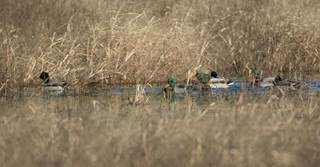Understanding Waterfowl: Survival of the Fattest
Maintaining fat reserves is crucial for waterfowl during the cold winter months
Maintaining fat reserves is crucial for waterfowl during the cold winter months
By John Veon and J. Dale James, PhD
For people, being fit involves watching what we eat and getting regular exercise. To be healthy and enjoy a high quality of life, we try our best to avoid putting on too many pounds. For wintering waterfowl, however, the opposite is truea healthy bird is a bird that is able to maintain its fat reserves. Typically, higher body mass and fat reserves increase chances of survival and, for some species, reproductive success.
In general, seasonal changes in body mass of wintering waterfowl are common and generally follow a similar pattern. The birds arrive on the wintering grounds with a relatively low body mass after using stored reserves during the fall migration. In early winter, waterfowl continue to eat and increase body mass as they store fat. During this time, mallards and other dabbling ducks shift to a diet that is higher in carbohydrates, consisting of agricultural grains such as rice and corn and the seeds of native plants like wild millet and smartweed. These foods provide nearly double the energy of invertebrates and other protein-rich food sources.
Body mass in ducks often declines from mid- to late winter. Research suggests that this decline is probably controlled by endogenous (internal) mechanisms. As winter progresses, birds maintain lower fat reserves, possibly as an adaptation to balance energy needs with the risk of predation while foraging. However, environmental factors such as limited food quality and availability can play a role as well.
Maintaining fat is especially important for waterfowl during winter, when harsh weather conditions can interrupt the birds ability to feed and acquire energy. Through a process called thermoregulation, ducks and geese burn fat to stay warm. Individual birds with a higher body mass and more fat reserves can sustain longer periods of harsh, cold weather than birds with a lower body mass. If harsh weather persists, the birds fat reserves may become insufficient to sustain them. At this point they must either migrate or face starvation and eventual death.
As late winter draws to a close and spring migration approaches, ducks begin to increase their body mass once again by undergoing what is known as hyperphagia. This behavior, in which ducks consume food at a higher rate and increase the storage of fat, prepares the birds for the energetic demands of spring migration. As they fly north to nesting areas, waterfowl rest and refuel at migration stopover sites to replenish fat reserves. Research has revealed that ducks spend anywhere from one day to nearly a month at stopover locations to acquire fat and nutrients before continuing their trip.
A variety of high-quality foraging habitats are required to meet the birds complex dietary needs throughout migration and winter. Although waterfowl have adapted well to agricultural landscapes, natural wetlands still provide crucial food resources and habitat. Unfortunately, nearly 80 percent of natural wetlands have been converted to other uses on some key waterfowl wintering areas. In addition, more efficient farming equipment leaves less waste grain on the ground, and many grain crops are harvested earlier in the fall than in the past, providing less food for waterfowl on agricultural landscapes. And to make matters worse, on some wintering areas growing populations of snow geese now compete with other waterfowl for limited food resources and are capable of significantly reducing localized foraging capacity for ducks in a matter of days.

Photo Edward Wall
For these reasons, Ducks Unlimited and its partners are continuing to implement wetland conservation projects across all landscapes that are important to waterfowl. It is especially important to maintain voluntary habitat conservation programs, such as the Natural Resources Conservation Service Wetland Reserve Easement program, the Texas Prairie Wetlands Project, the Rice Stewardship Partnership, and the Arkansas Waterfowl Rice Incentive Conservation Enhancement program, all of which provide incentives for farmers to restore wetlands and provide agricultural food resources for waterfowl.
By assisting waterfowl in maintaining their body mass during the wintering period, habitats with abundant food resources are crucial to the birds survival and future reproductive success. Consequently, Ducks Unlimited, government agencies, farmers, and other private landowners are working together to ensure that waterfowl have the habitat and the variety of foods they need to thrive over the winter.
John Veon is a graduate student pursuing a Master of Science at the University of Arkansas in Fayetteville, and Dr. Dale James is director of conservation science and planning in DUs Southern Region.
Did You Know?
Ducks Unlimited uses cookies to enhance your browsing experience, optimize site functionality, analyze traffic, and deliver personalized advertising through third parties. By continuing to use this site, you agree to our use of cookies. View Privacy Policy